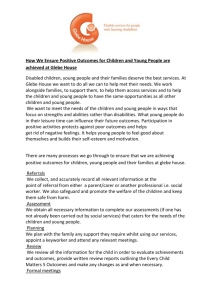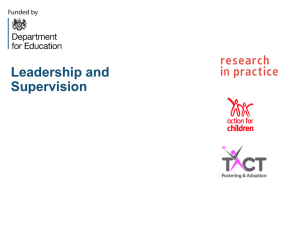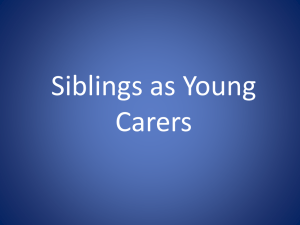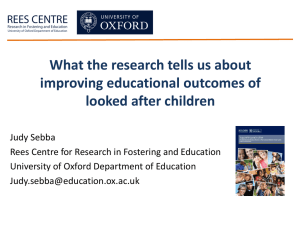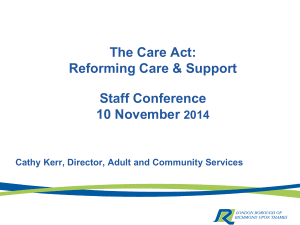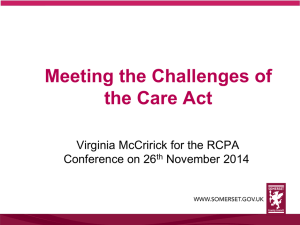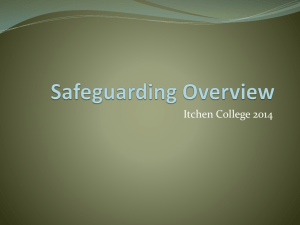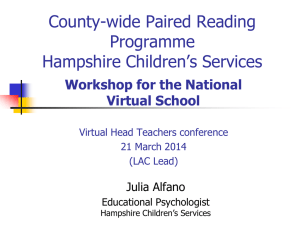FP3 Improving the mental health of looked after children
advertisement
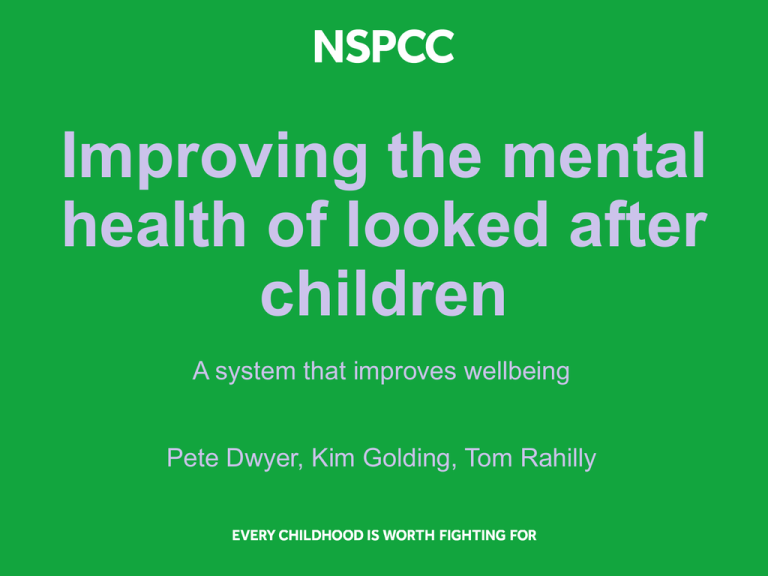
Improving the mental health of looked after children A system that improves wellbeing Pete Dwyer, Kim Golding, Tom Rahilly Too often we describe a single response • Each child in care has a unique history & formulation. We must avoid simplistic accounts. “Because she is LAC she is X…” o Traumatised o Attachment problems o Anxious o Shameful o Without even seeing her, I can tell you she needs ‘Y’ • We cannot lump all children in care together. Histories are complex and hard to trace, without a single pathway. We need to develop a personalised system of support. 3 Identifying how support can be improved • 4 local authorities and their partners • Fieldwork • Research review by Oxford University • Expert Interviews • Horizon Scanning of best practice • Service and system design workshops • Prototyping approaches We have spoken to… 42 children in care 56 foster carers 9 residential care workers 19 looked after children social workers 6 fostering & adoption social workers and managers 6 leaving care workers 8 IROs 10 CAMHS professionals 4 health professionals 7 staff from education services 1 children’s rights manager 2 placement team workers 1 Lead Member 7 voluntary sector representatives 4 Variation in support Things got difficult with my auntie after 4 years and I had to leave. This foster care placement was meant to be long-term. It lasted 6 months. I was really upset. Went to live with my auntie when I was 10 in 2009 + Temporary foster care placement (4-5 months). They were nice. Temporary foster care placement. She was so uptight. She said I was rude and messy Moved to children’s home. I really like my key worker, she makes me laugh. I’ve got my sparkle back. 5 How we can improve support A review of the research identifies that: 1. Wellbeing is amenable to change 2. Early interventions are more likely to promote good mental health 3. Developing relationships is crucial for children to make progress 4. Carer training is a promising method for influencing children’s outcomes 5. Continuity (permanence, stability and consistency) can influence success 6 How we can improve support 6. Interventions need a clear theoretical base but should be open to more than one interpretation of behaviour 7. Caregivers’ attitudes can affect the take-up and success of mental health services 8. Efforts to improve mental health should be systematic and sustained 9. Children and young people should be treated as individuals 10. Professionals need to listen to children and young people 7 A system that supports children in care An emphasis on mental health embedded throughout the system A proactive & preventative approach to supporting good emotional wellbeing Relationships in the child’s life are supported & sustained Children have a strong sense of voice and influence Care leavers have access to emotional support 8 The role of specialist services in delivering this vision 9 Specialist services Quality Standard 5: Looked after children and young people receive specialist and dedicated services within agreed timescales. Multi-Agency Working Quality Standard 2: Collaborative working between professionals and services, including carers, promotes high-quality and consistent care and a stable experience of placements for looked-after children and young people Quality Standards for the health and well being of looked after children and young people. NICE, April 2014 Effective Services • Multi-disciplinary assessments to ensure children’s mental health needs are identified early (Tarren-Sweeney, 2010) • Carer support as well as therapeutic interventions for the children (Milburn et al, 2008) • Multi-agency working with accessible and child-friendly health services (Golding, 2010) • Assessment and intervention are provided when needed, irrespective of placement stability (Minnis, H. & Del Priore, C. (2001; Vostanis, 2010) • Indirect work such as parenting support provided alongside more direct interventions (Anderson et al, 2004) Assessment • Children and young people need specialist assessment of their emotional and mental health needs on entry to care and during their time in care. • Social Services working in partnership with carers, health services and schools will ensure the child or young person has access to appropriate support services to meet the needs identified. • This support is needed early on in their care journey to prevent the onset, or worsening, of mental health problems. Specialist services • Children & carers need access to dedicated mental health services with specially trained staff working within a multi-agency approach. • CAMHS can quickly get overwhelmed by demand, complexity and the long-term nature of the difficulties presented. • Combine mental health support with parenting support, good care planning and classroom support. • Broad focus on building resilience rather than a narrow focus on symptom reduction. • Creative and flexible ways of working including parenting and emotional support for carers, and building children’s resilience and social and emotional competence through arts and leisure activities as well as specialist therapies. Importance of Multi-agency working • Facilitates working together with more open lines of communication. • Ensures shared understanding of the children and their needs. Curiosity and reflection instead of defensive practice. • Facilitates greater understanding of roles of other agencies. • Enhances knowledge and expertise of professionals and family. • Improves access and more appropriate referrals between services. • Reduces conflicting demands and advice. Multi-agency therapeutic support • Integrating and raising a child within a substitute family or a family with a high level of social care support is a complex process. • Sensitive professional involvement can increase the chance of successful fostering. • Insensitive, fragmented professional involvement can decrease the chance of success. • Multi-agency therapeutic networks can facilitate shared understanding, and collaborative working that keeps the family central. ISLA Multi-Agency Service: Worcestershire • An integrated service across health, education and social care for carers, children and young people and other professionals. • Provide holistic health assessment • Promote inter-agency working. • Provide direct support to carers, children and young people through consultation, specialist parenting advice, specialist training and therapeutic input as appropriate. Impact on multi-agency working Independent evaluation of views and perceptions of service users: • Improved integration across agencies had been achieved. • Involvement of all agencies seen as beneficial by carers and support workers. • Carers felt less isolated • Access to ‘systems’ had improved in some cases. • Improved inter-agency links anticipated in future because of intervention. Paul McDonald, 2002 ‘I have a better idea of working with people operating in other systems’ (social worker) ‘Listening to input from other colleagues and gaining further background information improved overall understanding and sharing of ideas’ (headteacher) ‘I never had this access to the school before’ (foster carer) ‘An excellent point of access for advice on other services or resources from an experienced team.’ (Residential manager) Putting this into practice in North Yorkshire 19 Why participate? • Developing a greater understanding of not only needs but also “what works” • Help LAs translate those messages from research into practice. In addition: • We were conscious our LAC strategy lacked real sophistication in this area • We were rewriting our “Emotional and Mental Health” Strategy and the CAMHS specification 20 Proposals for improvement Mainstream improvement priorities - not CAMHS only! • Better assessment of emotional needs, ideally prior to coming into care to provide better baseline • Increasing real placement options and choice • Proactive support to prevent placement disruption • Greater support and on-going work with birth families • Providing consistent trusting and meaningful relationships with professionals • Build resilience e.g. social and leisure opportunities. • Improve transitions from children’s to adults 21 Proposals for improvement I would add… • Educational outcomes in their widest sense: CYPP priority • Peer relationships • And CAMHS! 22 What will we do differently? • Consistent assessment of emotional needs which then trigger proportionate response: e.g. volunteer mentor or CAMHS clinician • Innovation Programme: supporting placements, reducing disruption and providing professional continuity • Improving Transition to Adults: Staying Put, improved flexible accommodation/support options/celebrating success • Improving contact with natural family • Embedding strategically: CYPP/Emotional and Mental Health Strategy and CAMHS specification 23 Thank You 24
